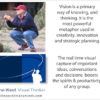The Kinesthetic Modeling (KM) session Monday at VizThink was a sellout. Tuesday, many conferees were asking for an encore. That evening after dinner a second group got together. They were intrigued to experience how simple kinesthetic activity liberates visual expression and original thinking.
Be sure to check out David Sibbet’s perceptive post about the evening session at http://www.davidsibbet.com/david_sibbet/2009/03/kinesthetic-modeling-whole-body-vizthink.html
 The process is a goofy one, admittedly. First, you dump some stuff (Holy Scrap!) out on a table and arrange it so that it says something about yourself. You’re not allowed to explain it. Instead, you let other people tell YOU what it “looks like”, but not “what it means”. And finally you can say what you were up to. All the while, your table mates are writing down what people are saying so that you can take it all in.
The process is a goofy one, admittedly. First, you dump some stuff (Holy Scrap!) out on a table and arrange it so that it says something about yourself. You’re not allowed to explain it. Instead, you let other people tell YOU what it “looks like”, but not “what it means”. And finally you can say what you were up to. All the while, your table mates are writing down what people are saying so that you can take it all in.What’s going on here? Well, this icebreaker is designed to coax you out of your abstract intellectual take on “reality”. If you’re going to use KM to do some original thinking about something that vexes you, you’d better side track your stale habitual thought patterns. The KM process is rooted in the idea that your thinking begins with sensation and proceeds to imagery then to metaphor and later (only milliseconds later) to explaining and intellectualizing your experience: from visceral to conceptual. If you can just get back to that first take on something that is important to you, you have a shot at getting beneath the knee jerk intellectual categorizing that we all do, especially in a crisis. KM literally gets people unstuck. The more hidebound they are, the better it works.
Below is one of the models that was made at this stage
Dan gave an eloquent explanation of how it shows the way he, a lawyer, works. Wherever you are Dan, I hope you will comment on this model. I, for one, am always moved by the sophistication of the expression. KM seems to access people’s innate ability to think visually and there does not appear to be a learning curve the way there is with drawing. People just do it. And their delight in the process is disarming.
THOUGHT ARTIFACTS
You can understand the models as thought artifacts. For a short time after they are made a group can use them as armatures for all their thinking around an important issue. Because the thoughts are externalized in the form of simple objects, the thinker is less likely to feel vulnerable or be attacked for what she has made. And because the models are so unassuming they are easy to rearrange as ideas evolve.
SERIOUS MODELING
It is only a short hop from the icebreaker to the modeling of extremely complex situations. In both VizThink workshop sessions we tackled the impact that the global financial collapse will have on the VizThink community. In less than 20 minutes each table generated a rich model of the existing situation, which was then ready for de-brief. In KM, examining the model is where the value is extracted. A short modeling activity can often generate a day of powerful conversation.
The de-briefs followed much the same pattern as the icebreaker, progressing from what it looks like to what it means. Then each table was asked to suggest options that the VizThink community could consider to remain viable through the hard times ahead. At VizThink we only had time for a quick flyby. But you will see that, even in this brief exercise, there is a wide range of thinking. Nothing seems to be off limits; and you can see that even these hasty models could serve as springboards for rich strategic discussions. As we wrapped up the modelers at most tables felt that they had barely mined the significance and potential of what they had made. The groups’ comments were captured graphically Monday afternoon by Regina Rowland and Julie Gieseke; and on Tuesday evening by Nick Payne. Their charts are below.
In less than an hour the models are full of inspiration & practical suggestions,
the products of many people thinking together simultaneously with their hands.
The VizThink Community as a DIASPORA!
Kinesthetic Modeling is a facilitation and coaching tool designed for professionals in organizational settings. You can give it a try based on the information in this post. Or, if you want to learn how to facilitate the process for others, workshops are available. See the link in the right column of this blog. For more pictures and all of the meeting graphics associated with this session, click the “VizThink09” slideshow link in the right column of this blog. (coming soon)






Leave a Reply